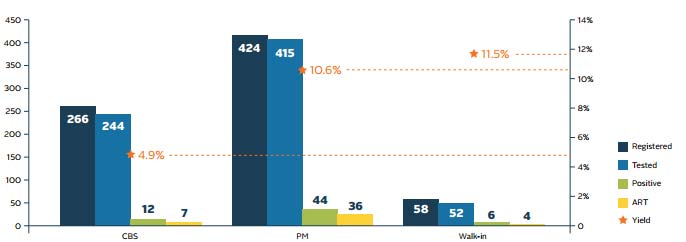- What We Do
- Agriculture and Food Security
- Democracy, Human Rights and Governance
- Economic Growth and Trade
- Education
- Ending Extreme Poverty
- Environment and Global Climate Change
- Gender Equality and Women's Empowerment
- Global Health
- Water and Sanitation
- Working in Crises and Conflict
- U.S. Global Development Lab

Implementing partners in Chiang Mai are finding that peer mobilizers significantly increase their project coverage. From July to December 2015, community-based supporters recruited 266 clients, while peer mobilizers recruited 424. As peer mobilizers take responsibility for recruitment, community-based supporters have more time to focus on one-on-one communication, resulting in overall higher rates of HIV testing and counseling (HTC) uptake than traditional, group-based education. Community-based supporters are denoted as CBS and peer mobilizers as PM on the graph above.
May 2016—Less than half of all men who have sex with men in Asia know their HIV status. Current models of outreach-based promotion of HIV testing and counseling (HTC) have largely experienced low success rates in testing and identifying HIV positive individuals.
The U.S. Agency for International Development (USAID), through the U.S. President's Emergency Plan for AIDS Relief, funded LINKAGES Thailand program, implemented by FHI 360 in partnership with local community-based organizations Mplus Foundation and Caremat, has introduced an enhanced peer mobilizer model to increase HTC and improve enrollment in care for those who test positive. This model focuses on: 1) targeted, one-on-one interpersonal communications between clients and trained, salaried community-based supporters; and 2) an informal network of incentivized peer mobilizers who recruit clients from within their social and sexual networks.
Number 10* is a volunteer peer mobilizer, who receives incentive payment for each eligible client he successfully recruits for HIV testing. When LINKAGES asked him to refer his friends, he developed a banner advertisement for a Facebook fan page he moderates. Facebook users interested in getting tested contact him directly, and Number 10 shares his personal testing experiences and links the client to a community-based supporter who helps the client access a LINKAGES-supported HTC site.
Like other peer mobilizers, Number 10 also has offline friends whom he tries to persuade to get tested. Number 10 considers enhanced peer mobilizer (EPM) an effective model and says that the monetary incentive is a good "morale boost." However, he says the money is not the main motivation for being a peer mobilizer. "To me, every time I refer one of my friends to get tested, it means that I have helped my friend to have better health – I feel delighted!" Number 10 said.
Over a 6-month period, Number 10 successfully reached 149 new clients, of whom 93 percent received an HIV test. The majority of those tested had never before received an HIV test, and 18 percent were found to be HIV positive.
Implementing partners in Chiang Mai have indicated that peer mobilizers significantly increase their project coverage. From July to December 2015, community-based supporters directly recruited 266 clients, while peer mobilizers recruited 424. As peer mobilizers take responsibility for recruitment, the community-based supporters themselves have more time to focus on one-on-one communication, which results in higher rates of HIV testing than traditional, group-based education approaches.
Like Number 10, many of the more successful peer mobilizers are well connected via social media, which they use to rapidly disseminate information to a wide network of contacts. These peer mobilizers collect contact information from everyone willing to participate in LINKAGES and share it with community-based supporters, who can contact them directly.
Community-based supporters also strategically arrange meetings with these potential new clients in venues adjacent to LINKAGES-supported, community-based HTC centers, so that if clients indicate interest in testing, they can be immediately escorted across the street and registered at the clinic.
As a result of their success, as many as 13 other provinces across Thailand have expressed interest in implementing an enhanced peer mobilizer model next year. The model is also being implemented under LINKAGES in Laos. LINKAGES partners in Cameroon, Suriname, and Trinidad and Tobago are receiving technical assistance to adapt this model to their own program context.
The story of Number 10 demonstrates that social network recruitment, through an informal peer cadre that complements a standard outreach workforce, can improve HIV testing uptake and get more people on treatment. It is an outreach model that offers a more effective, sustainable and cost-efficient approach to HIV testing and antiretroviral treatment initiation than traditional outreach models.
*Name chosen by individual to protect his anonymity
Additional Links
- Follow LINKAGES on Facebook and Twitter
- Check out LINKAGES on the web
- Read LINKAGES' blog posts
- Visit the USAID Office of HIV/AIDS Website for Key Populations
- Visit the USAID LINKAGES Website







Comment
Make a general inquiry or suggest an improvement.